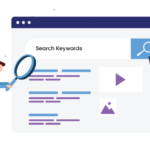Insurance SEO: We help Insurance Brokers and Professionals grow with SEO

Get a free discovery audit and detailed proposal for your business
Components of a great SEO solution for insurance companies
Regardless of the industry, a few core areas should be the focus for good SEO. This includes precise keyword research, technical optimization, pertinent content, and link acquisition. Insurance companies that are striving to be competitive in their local markets should pay close attention to local factors and signs to better associate themselves with the local and regional market.
Below, we’ll present each core component and discuss how it applies to insurance companies and your business.
Keyword research for Insurance Companies
Depending on the specific services in which you specialize, this area of research can vary. There are various different categories of keywords we like to look at for insurance companies that are general high volume keywords, local geo-modified keywords, and supporting long-tail keywords.
1. General keywords
This group of keywords are the higher volume more general keywords that you will target that will likely include the types of services you specialize in. Some examples might be:
Insurance
Insurance companies
Insurance quotes
Auto insurance
Health insurance
Insurance companies near me
While at first glance these keywords may feel very competitive, understand that Google knows that there is a local intent to these keywords – for example: the results that are displayed for someone in Indianapolis may be quite different than for someone searching in Houston.
2. Local geo-modified keywords
This group of keywords are similar to the above general keywords but include a geo-modifier that could be the local city or suburb you’re competing in.
Similar to the above, this could be:
[city] insurance companies
Insurance companies in [city]
[city] auto insurance companies
While your rankings will likely be very correlated between these two groups (if you rank locally for the general terms, odds are you’ll also rank for the geo-modified search terms), understanding that there are a few differences is important.
3. Supporting long-tail keywords
Long-tail keywords can form an excellent local content strategy and a basis to help educate your potential clients. View these keywords as very early in the purchasing decision, and usually occurring during the research phase. Getting out in front of potential clients at this stage helps increase your brand awareness as well as establishing and building trust during their buying journey.
Some of these keywords might include:
How much does auto insurance cost?
How to choose an insurance company?
Do I need health insurance?
What is the best way to shop for insurance?
Can I use the same insurance company for all of my insurance needs?
An individual searching for one of the above may not be immediately ready to call or make a purchase. However, they’re actively searching for information about insurance companies. Spotting these opportunities and building out content will establish you as an authority in your particular industry while improving overall visibility for other keywords.
After going through proper keyword research, make sure to follow our advice for mapping those keywords – then preparing a master document to follow the mapping process will help on-page optimization as well as content creation.
Technical and Website Optimizations for Insurance Companies
While the keyword research will help dictate some of the optimizations we do to the website, identifying technical limitations and issues to the site may help reveal some low hanging fruit that can be beneficial for visibility.
There are literally dozens of tools that you can use to do this type of analysis. We love using the tool Sitebulb as it allows us to dig deep into the data while effectively visualizing it as it becomes actionable.
Based on the technical audit and your keyword research, you should now have a fairly robust keyword mapping document that you can use to add page-level optimization information in addition to some of technical optimizations that can be done on the website-level to help improve visibility.
Don’t devalue or skip this step in the process. Having good SEO audit information and optimizing the technical aspects of your site can significantly improve your visibility and boost you ahead of your competitors in the insurance company field.
Adding and Optimizing Website Content to Support SEO
We continue to see this as most likely the largest problem area when working with insurance SEO. Having good product and service content with precise keyword placement is important for increasing your visibility.
Taking this a step further and building out content strategy that includes writing on the topics uncovered during your keyword research will help set apart from your competitors.
We don’t mean to just write for the sake of writing. It is imperative to note that if your piece of content fails to add value for your website visitor – then remove it from your website. Be positive that your content is top notch, that it answers your client’s questions, and that it’s engaging in a manner that encourages them take action.
Don’t be stressed about content. Begin by chipping away at the optimization or mapping document and optimize your current content, and fix and optimize titles and meta data. Add relevant internal links, and include keywords when natural and relevant. You will be surprised how much positive difference you can make by only optimizing existing content before ever writing more.
Link Acquisition, Citations, and Website Promotion within the Insurance Industry
Full disclosure? We all have either been burned or know someone who has been burned by outdated SEO practices and short-term thinking. There are many different ways to acquire links within the Insurance industry. On the issue of ranking for local search terms, here’s how you get started:
1. Get local, national, and if possible industry-specific citations. Citations are instances of your business’ name, address, and phone number that appear across the web. Getting your business information into these top directories is basically the ante for local SEO. It’s not necessarily going to move the needle considerably if the competition is high, but it’s a must-do for local optimization.
I’m not sure what else to say about this one. If your business isn’t already on Google My Business, Bing Maps, Apple Maps, etc. then you need to do this before considering other aspects of link building.
2. Leverage your existing partnerships. After you feel comfortable with where you are sitting in terms of citations and brand visibility, it’s time to move to obtaining the low-hanging-fruit links. These are usually links from partner companies within your industry. Know a roofer that you refer business to? Have a friend who’s a realtor? Connect with these people and ask for a link to your website – it could be as simple as a link from a resource page on their site. You’ll be surprised just how many links you can acquire through this method.
3. Resources for industry partners. Continuing on the partnership theme, we’ve seen a lot of success in creating valuable local and sharable resources that you can give away to your industry partners.
This could be something like what you need to know about homeowner’s insurance before purchasing a new home that you offer to realtors in the area and have them feature it on their website with a link back.
4. Industry associations. Your national, state, or local level Insurance Company Associations are a great source for links. Whether it’s as simple as a member listing, or as robust as arranging guest posting opportunities, these associations are often looking for great high quality content to feature on their website or for their members – trading this content for links and visibility can often be well worth the effort.
5. Broken link building. This is likely one of the most popular methods of link acquisition in the SEO space today and for good reason – it’s about as safe as it gets and it’s effective in getting results.
There’s a lot that goes into a good broken link building process that we won’t cover in this post, but at a high level, you crawl through high authority industry websites to identify any broken links they may have. Then create resources for these sites and present them as an alternative link than the broken one – resulting in great authority with often very minimal work.
Industry Insights
Stay in the know
Get the latest insights delivered right to your inbox. Stay in the know on both SEO and agency life and connect with other like-minded professionals.



